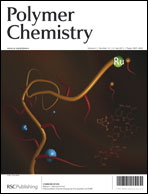Herein, a new conjugated poly(pyridinium salt), poly{(4,4′-(1,4-phenylene)bis(2,6-diphenylpyridinium))-co-N-butyl-3,6-carbazolylene ditosylate} (Poly1), exhibits aggregation-induced emission (AIE) characteristics. It is weakly emissive in solution but highly luminescent in the aggregate state. A fluorescence turn-on biosensor for calf thymus DNA (ctDNA) detection and quantification is developed by taking advantage of complexation-induced aggregation of Poly1, which increases the polymer fluorescence in aqueous solution. It was found that the fluorescence intensity of Poly1 in ethanol–phosphate buffer solution (2 mM, pH 7.4) (v/v 1 : 1) was increased up to about 2.4 folds when the concentration of ctDNA increased from 0 to 95 μM along with the blue-shift of the emission peak from 604 to 586 nm. In the concentration range from 0 to 60 μM, the ratio of the increase in photoluminescent intensity at 604 nm in the presence of ctDNA (IctDNA – I0) to that in the absence of ctDNA (I0) is linearly proportional to the concentration of ctDNA with a correlation coefficient of 0.997. The detection limit was calculated to be of 1.2 μM based on the results of fluorescence titration.

You have access to this article
 Please wait while we load your content...
Something went wrong. Try again?
Please wait while we load your content...
Something went wrong. Try again?


 Please wait while we load your content...
Please wait while we load your content...